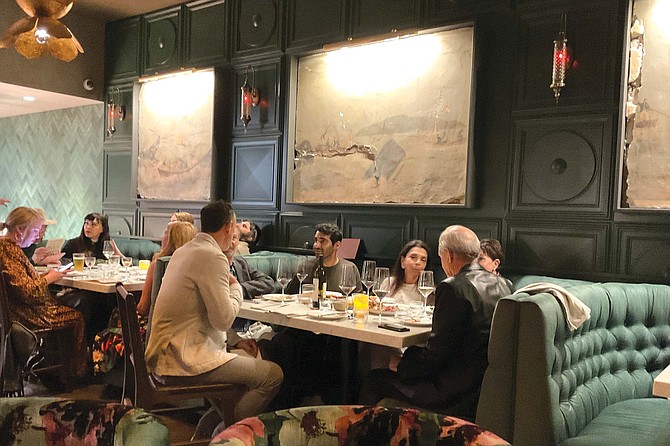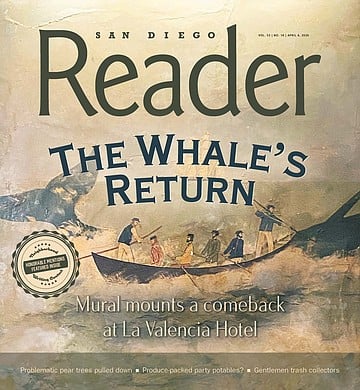 Facebook
Facebook
 X
X
 Instagram
Instagram
 TikTok
TikTok
 Youtube
Youtube

Whew. Something has been made right in La Jolla. For the last decade, everybody I’ve spoken to has talked as if a little piece of this town’s soul had been ripped out. A piece that used to make them feel that their neighborhood amounted to more than a tourism magnet or a luxury dormitory. And then, during a recent evening stroll down Prospect, the magic happened. “They’ve opened it back up!” said this elderly gentleman on the sidewalk outside The Pink Lady — La Valencia Hotel. He stood, looking awestruck at the bar. Oh wow. It’s The Whaling Bar.

Last time I looked, The Whaling Bar was dead and buried. Some ten years ago, it was turned into the somewhat vapid Cafe La Rue. Big on expensive, small on lore. I counted it a loss. I had willingly drunk the Kool Aid on the old place’s romance. (My great great-great-granddaddy was a whaler, so I guess I was predisposed.) They had this 20-foot mural which I was pleased to see took the whale’s side of the story — or at least, there was some sympathy contained in the title: “The Whale’s Last Stand.” It was painted by Wing Howard, who tuned into the kinda literary notoriety that La Jolla’s own Rat Pack was giving the joint. Because, you think La Jolla, you think noir. Raymond Chandler was primus inter pares here, and he was beautifully noir in his writing. The Big Sleep. The Long Goodbye. Farewell, My Lovely. Not to mention Playback, his last novel, which is interesting on a local level, because he set it in Esmeralda, which was his code for La Jolla, where he lived the final years of his life. At this very bar, he drank, talked, and probably argued with his buddies, among them Gregory Peck and Theodore Geisel (Dr. Seuss himself). Other regulars dropping in here were probably too young for him: Jack Lemmon, Tom Hanks, Robin Williams, and La Jolla luminaries like Jonas Salk (who, let’s remember, you anti-vaxxers, pretty-much saved humanity from polio with his vaccine), as well as Joan Kroc, and Sol Price, the Price Club founder.
Chandler liked The Whaling Bar because a) this pretty cool group had the makings of a bona fide artists’ colony, b) a real artists’ colony, the Green Dragon, was situated right below the hotel, and c) he himself was a serious drinker who liked a serious bar. He said it himself: “I like bars just after they open for the evening. When the air inside is still cool and clean, and everything is shiny, and the barkeep is giving himself that last look in the mirror to see if his tie is straight, and his hair is smooth. I like the neat bottles on the bar back, and the lovely shining glasses and the anticipation. I like to watch the man mix the first one of the evening, and put it down on a crisp mat, and put the little folded napkin beside it. I like to taste it slowly. The first quiet drink of the evening in a quiet bar — that’s wonderful.”
La Valencia hotel opened in 1925. They created The Whaling Bar in 1949. It lasted 74 years, through 2013. Then, La Rue. But it turns out the town council petitioned the hotel to reopen The Whaling Bar, at least according to one manager on this night, which is — pure luck! — its soft opening. We’re surrounded by patches of Wing Howard‘s whaling mural, now broken up into four separate panels. Some folks are celebrating by ordering “The Whaler,” the joint’s signature cocktail of cognac, coffee liqueur, Irish whiskey and home-made ice cream.
“Do you know what barstool Raymond Chandler actually sat on?” I ask. “No, but somewhere on that side of the room,” the manager says. “Doctor Seuss used to have a plaque in one of the booths. We want to put one back in. Gregory Peck used to be the artistic director for the theater in La Jolla. So all of his co-stars would come here. People are so interested, we did a whole staff training about the history of La Jolla. We’re very excited to see what people think of this vuelve a la vida.” Me, I think it’s grand.


Whew. Something has been made right in La Jolla. For the last decade, everybody I’ve spoken to has talked as if a little piece of this town’s soul had been ripped out. A piece that used to make them feel that their neighborhood amounted to more than a tourism magnet or a luxury dormitory. And then, during a recent evening stroll down Prospect, the magic happened. “They’ve opened it back up!” said this elderly gentleman on the sidewalk outside The Pink Lady — La Valencia Hotel. He stood, looking awestruck at the bar. Oh wow. It’s The Whaling Bar.

Last time I looked, The Whaling Bar was dead and buried. Some ten years ago, it was turned into the somewhat vapid Cafe La Rue. Big on expensive, small on lore. I counted it a loss. I had willingly drunk the Kool Aid on the old place’s romance. (My great great-great-granddaddy was a whaler, so I guess I was predisposed.) They had this 20-foot mural which I was pleased to see took the whale’s side of the story — or at least, there was some sympathy contained in the title: “The Whale’s Last Stand.” It was painted by Wing Howard, who tuned into the kinda literary notoriety that La Jolla’s own Rat Pack was giving the joint. Because, you think La Jolla, you think noir. Raymond Chandler was primus inter pares here, and he was beautifully noir in his writing. The Big Sleep. The Long Goodbye. Farewell, My Lovely. Not to mention Playback, his last novel, which is interesting on a local level, because he set it in Esmeralda, which was his code for La Jolla, where he lived the final years of his life. At this very bar, he drank, talked, and probably argued with his buddies, among them Gregory Peck and Theodore Geisel (Dr. Seuss himself). Other regulars dropping in here were probably too young for him: Jack Lemmon, Tom Hanks, Robin Williams, and La Jolla luminaries like Jonas Salk (who, let’s remember, you anti-vaxxers, pretty-much saved humanity from polio with his vaccine), as well as Joan Kroc, and Sol Price, the Price Club founder.
Chandler liked The Whaling Bar because a) this pretty cool group had the makings of a bona fide artists’ colony, b) a real artists’ colony, the Green Dragon, was situated right below the hotel, and c) he himself was a serious drinker who liked a serious bar. He said it himself: “I like bars just after they open for the evening. When the air inside is still cool and clean, and everything is shiny, and the barkeep is giving himself that last look in the mirror to see if his tie is straight, and his hair is smooth. I like the neat bottles on the bar back, and the lovely shining glasses and the anticipation. I like to watch the man mix the first one of the evening, and put it down on a crisp mat, and put the little folded napkin beside it. I like to taste it slowly. The first quiet drink of the evening in a quiet bar — that’s wonderful.”
La Valencia hotel opened in 1925. They created The Whaling Bar in 1949. It lasted 74 years, through 2013. Then, La Rue. But it turns out the town council petitioned the hotel to reopen The Whaling Bar, at least according to one manager on this night, which is — pure luck! — its soft opening. We’re surrounded by patches of Wing Howard‘s whaling mural, now broken up into four separate panels. Some folks are celebrating by ordering “The Whaler,” the joint’s signature cocktail of cognac, coffee liqueur, Irish whiskey and home-made ice cream.
“Do you know what barstool Raymond Chandler actually sat on?” I ask. “No, but somewhere on that side of the room,” the manager says. “Doctor Seuss used to have a plaque in one of the booths. We want to put one back in. Gregory Peck used to be the artistic director for the theater in La Jolla. So all of his co-stars would come here. People are so interested, we did a whole staff training about the history of La Jolla. We’re very excited to see what people think of this vuelve a la vida.” Me, I think it’s grand.
Comments